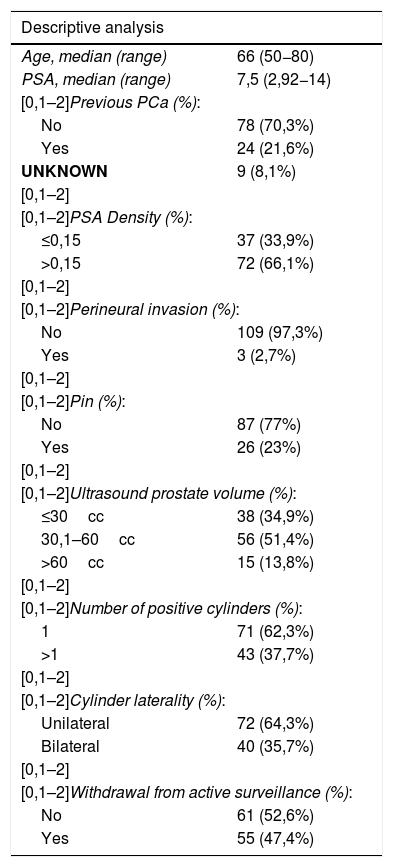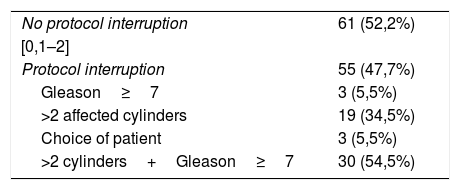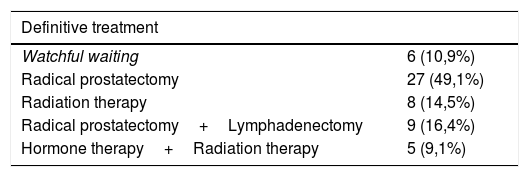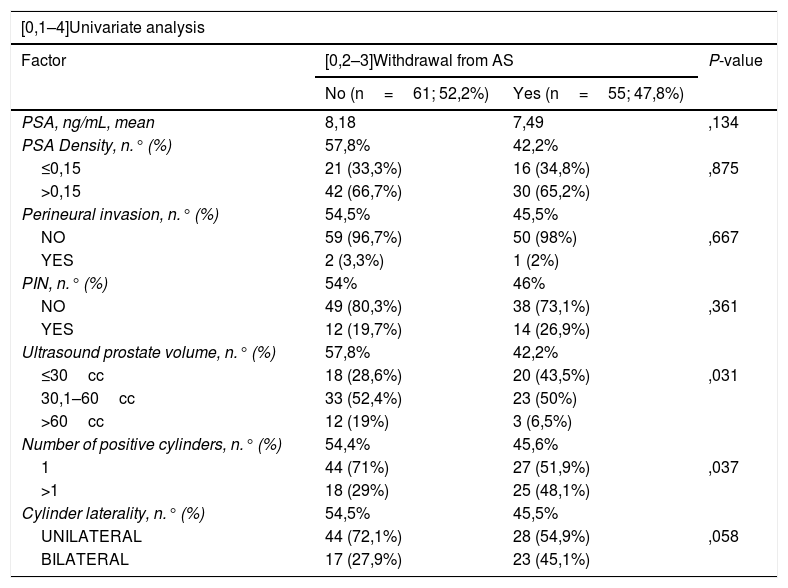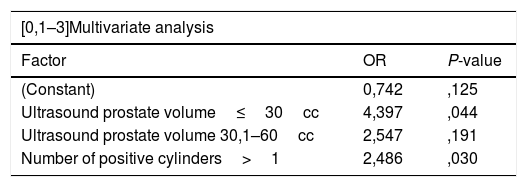Active surveillance (AS) has been established as a therapeutic strategy in patients with low-risk prostate cancer. Demographic and anatomopathological factors that increase the probability of reclassifying patients have been identified.
Materials and methodsLaboratory and histopathological data were collected from 116 patients included on AS since 2014. Univariate analysis was performed with Chi-square, t-student and Kendall's Tau, multivariate analysis according to logistic regression and Kaplan-Meier curves were calculated.
ResultsOf the 116 patients in AS, the median age at diagnosis was 66 years and the median follow-up was 13 months (2–72). Of these, 61 (52.6%) are still on surveillance, while 55 (47.4%) have left the program, mostly due to histological progression (52 patients (45.2%)); radical prostatectomy was performed in 27 (49.1%). Prostate volume (PV)≤60cc and the number of positive cylinders >1 in diagnostic biopsy (P=.05) were associated with higher reclassification rate in univariate analysis (P<.05). Multivariate analysis showed that these two variables significantly correlated with higher reclassification rate (PV 60 cc: OR 4.39, P=.04; >1 positive cylinder at diagnostic biopsy: OR 2.48, P=.03).
ConclusionsIt has been shown that initial ultrasound volume and the number of positive cylinders in the diagnostic biopsy are independent risk factors for reclassification. Initial PSA, laterality of the affected cylinders and PSA density were not predictive factors of progression in our series.
La vigilancia activa (VA) se ha establecido como estrategia terapéutica en pacientes con cáncer de próstata de bajo riesgo. Se han identificado factores demográficos y anatomopatológicos que aumentan la probabilidad de reclasificar a los enfermos.
Materiales y métodosSe han recogido datos analíticos e histopatológicos de 116 pacientes incluidos en VA desde 2014. Se ha realizado un análisis univariante con Chi cuadrado, t-student y Tau de Kendall, un análisis multivariante según regresión logística y se han calculado las curvas de Kaplan-Meier.
ResultadosDe los 116 pacientes en VA, la mediana de edad al diagnóstico fue 66 años y la mediana de seguimiento fueron 13 meses (2–72). De todos ellos, 61 (52.6%) siguen en vigilancia mientras que 55 (47.4%) han salido del programa, la mayoría por progresión histológica (52 pacientes (45.2%)) realizándose prostatectomía radical en 27 (49.1%). El volumen prostático (Vp)≤60cc y el número de cilindros positivos >1 en la biopsia diagnóstica (P=.05) se asociaron con mayor tasa de reclasificación en el análisis univariante (P<.05). En el análisis multivariante, estas dos variables se correlacionaron significativamente con una mayor tasa de reclasificación (Vp≤60cc: OR 4.39, P=.04; >1 cilindro positivo en la biopsia diagnóstica: OR 2.48, P=.03).
ConclusionesSe ha objetivado que el volumen ecográfico inicial y el número de cilindros positivos en la biopsia diagnóstica son factores de riesgo independientes para la reclasificación. El PSA inicial, la lateralidad de los cilindros afectos y la densidad de PSA no fueron elementos predictores de progresión en nuestra serie.






